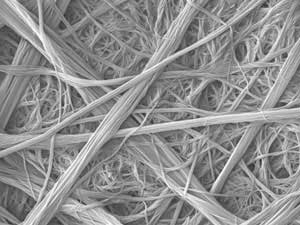| Posted: Mar 09, 2018 |
Building a better ion channel
(Nanowerk News) Artificial ion channels developed by A*STAR researchers could pave the way for new kinds of antibacterial agents and biomedical sensors (J. Am. Chem. Soc., "Combinatorial evolution of fast-conducting highly selective K+-channels via modularly tunable directional assembly of crown ethers").
|
|
Ion channels are biochemical superhighways that enable ions of metals such as potassium and sodium to zoom in and out of cells. Crucially, the channels are typically very selective, allowing only one type of ion through and barring others. For example, the naturally-occurring KcsA potassium ion channel can transport 100 million ions per second, and only lets one sodium ion through for every 10,000 potassium ions.
|
 |
| This scanning electron microscope image shows that the artificial ion channels self-assemble into fibers. (© American Chemical Society)
|
|
“But protein-based ion channels are costly and difficult to manipulate,” says Huaqiang Zeng at the A*STAR Institute of Bioengineering and Nanotechnology. “Synthetic versions are therefore being developed to mimic and eventually surpass the functions exhibited by naturally-occurring protein channels.” However, it has been difficult to develop artificial channels that have a strong selectivity for potassium over sodium ions.
|
|
Zeng and colleagues have now developed ion channels that offer rapid potassium ion transport, with a selectivity that is among the highest reported for any artificial ion channel. The channel is formed from a series of identical molecules that stack on top of one another. Each molecule contains three components. At one end is a crown ether, a large ring of carbon and oxygen atoms; in the middle is an amino acid, which contains chemical groups that allow the molecules to stack in a specific pattern; and at the other end is a long, carbon-based ‘tail’. These molecules can self-assemble so that the crown ether rings line up to form a tube, which acts as an ion channel.
|
|
The researchers created a library of molecules using various amino acids, different lengths of alkyl chains, and crown ethers that contained five or six oxygen atoms. Then they formed membranes from the stacked channels, and tested their ion transport properties.
|
|
The most selective channel they studied contained a crown ether with five oxygen atoms, a phenylalanine amino acid, and an alkyl chain containing eight carbon atoms. This could transport 30 million ions per second, and was about ten times more selective for potassium ion than sodium ions. This offers a much better performance than previous artificial potassium ion channels based on crown ethers or other molecular scaffolds.
|
|
The molecules’ three components can be readily altered to fine-tune the channels’ properties, so Zeng is optimistic that his team can improve their performance further. They hope to test their optimized systems in medical applications, such as antibacterial agents or hair growth promoters.
|

